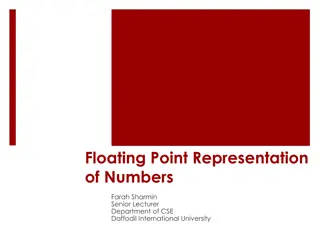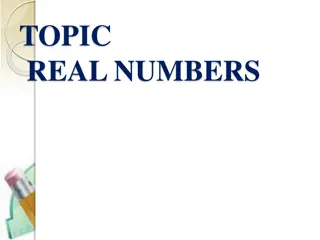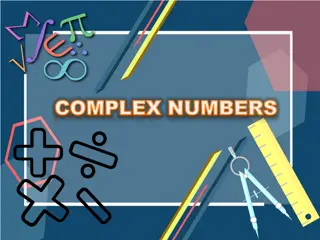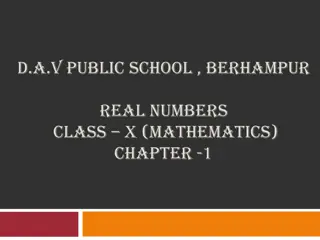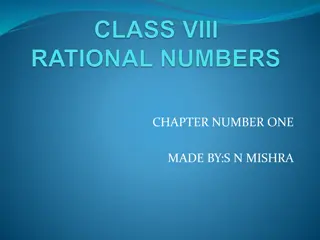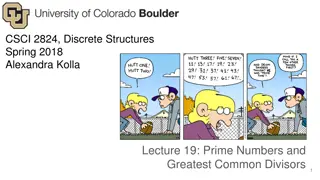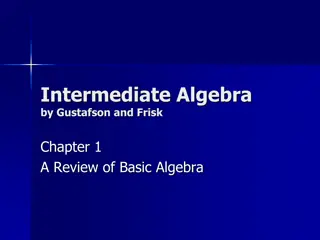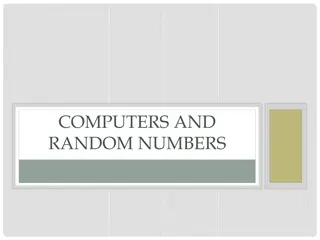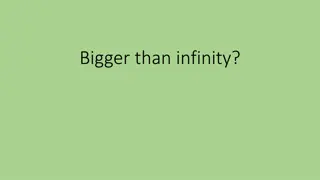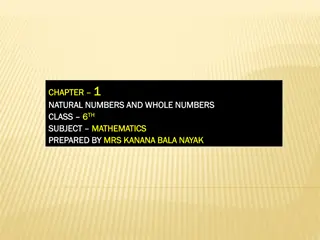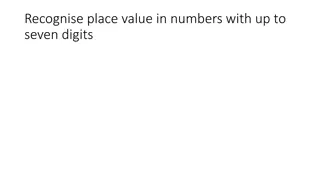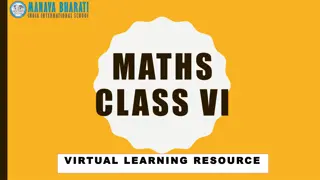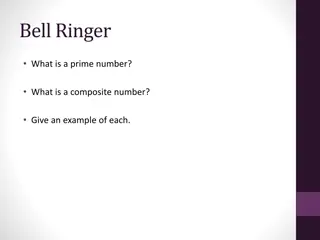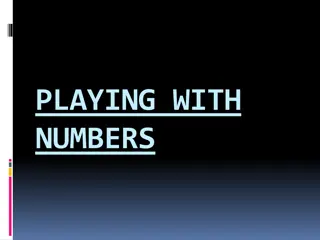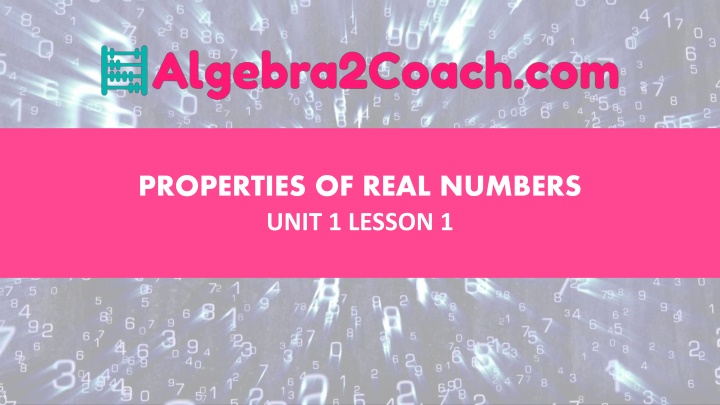
Properties of Real Numbers in Algebra
Explore the properties of real numbers in algebra, including the commutative, associative, and distributive properties. Learn about different types of real numbers and their characteristics. Enhance your knowledge to solve algebra problems effectively.
Download Presentation

Please find below an Image/Link to download the presentation.
The content on the website is provided AS IS for your information and personal use only. It may not be sold, licensed, or shared on other websites without obtaining consent from the author. If you encounter any issues during the download, it is possible that the publisher has removed the file from their server.
You are allowed to download the files provided on this website for personal or commercial use, subject to the condition that they are used lawfully. All files are the property of their respective owners.
The content on the website is provided AS IS for your information and personal use only. It may not be sold, licensed, or shared on other websites without obtaining consent from the author.
E N D
Presentation Transcript
PROPERTIES OF REAL NUMBERS UNIT 1 LESSON 1
OBJECTIVES STUDENTS WILL BE ABLE TO: identify various properties of real numbers. KEY VOCABULARY: Real numbers Commutative and Associative Properties of Addition. The Distributive Property. The Additive and Multiplicative Inverse Property. The Multiplicative Property of Zero.
PROPERTIES OF REAL NUMBERS 01 A Real Number is a value that represents a quantity along a continuous number line. Real numbers can be ordered. The symbol for the set of real numbers is script ,which is the letter R in the typeface "blackboard bold".
PROPERTIES OF REAL NUMBERS 02 The real numbers include: Counting (Natural) Numbers {1, 2, 3, ... } Whole Numbers {0, 1, 2, 3, ... } Integers {... , -3, -2, -1, 0, 1, 2, 3, ...} Rational Numbers (such as - , 6.25, ) Irrational numbers (such as ) 0,121221222 , 3,?
PROPERTIES OF REAL NUMBERS 03 Real Numbers Rational Numbers Integers Irrational Numbers Natural Numbers
PROPERTIES OF REAL NUMBERS 04 In pre-algebra, you learned about the properties of integers. Real numbers have the same types of properties, and you need to be familiar with them in order to solve algebra problems. 1 Commutative Property of Addition The commutative property of addition says we can swap added numbers over and still get the same answer ... 2 a + b = b + a
PROPERTIES OF REAL NUMBERS 05 Associative Property of Addition The associative property addition says that it doesn't matter how we group the added numbers (i.e. which we calculate first) (a + b) + c = a + (b + c) 3 Commutative Property of Multiplication The commutative property of multiplication is similar to that of addition. We can swap multiplied numbers over and still get the same answer ... a b = b a 4
PROPERTIES OF REAL NUMBERS 06 Associative Property of Multiplication The associative property of multiplication is similar to that of addition. We can group the multiplied numbers (i.e. which we calculate first) (a b) c = a (b c) 5 Distributive Property This property tells us that we get the same result when we multiply number by a group of numbers added together, or do each multiply separately then add them. a (b + c) = a b + a c 6 Here we get the same result when we multiply a by the sum of b and c or when we multiply a by b and multiply a by c then add the two products.
PROPERTIES OF REAL NUMBERS 07 Additive Identity Property Adding zero leaves the real number unchanged 7 a + 0 = a Multiplicative Identity Property Multiplying a real number by 1 leaves the real number unchanged. a 1 = a 8
PROPERTIES OF REAL NUMBERS 08 Additive Inverse Property Adding a real number to its negative, gives zero 9 a + (-a) = 0 Multiplicative Inverse Property Multiplying a real number by its reciprocal gives 1 10 a 1/a = 1
PROPERTIES OF REAL NUMBERS 09 Zero Property Multiplying any real number by zero gives zero 11 a 0 = a
PROPERTIES OF REAL NUMBERS 10 PROBLEM 1: Take each example, and first decide if the left and right sides of the equal signs are equivalent. That would mean the equals sign makes the statement true. Then, decide if the commutative property was used in the example. Example Are the sides equivalent? Does it use the Commutative Property? 2 + 4 = 4 + 2 2 5 = 5 2 4 2 = 2 4 2 6 = 6 2 2 = 2
PROPERTIES OF REAL NUMBERS 10 PROBLEM 1: Take each example, and first decide if the left and right sides of the equal signs are equivalent. That would mean the equals sign makes the statement true. Then, decide if the commutative property was used in the example. Example Are the sides equivalent? Does it use the Commutative Property? 2 + 4 = 4 + 2 YES YES 2 5 = 5 2 YES YES 4 2 = 2 4 NO NO 2 6 = 6 2 NO YES 2 = 2 YES YES
PROPERTIES OF REAL NUMBERS 11 PROBLEM 2: Take each example and first decide if the left and right sides of the equal signs are equivalent. That would mean the equals sign makes the statement true. Then, decide if the associative property was used in the example. Example Are the sides equivalent? Does it use the associative Property? (2 + 3) 7 = 2 + (3 7) 3(2 5) = (3 2) 5 6 (7 2) = (6 7) 2 10 + [4 + (2 + 5)] = [10 + (4 + 2)] + 5 2[4(5 3)] = [2(4 5)] 3
PROPERTIES OF REAL NUMBERS 11 PROBLEM 2: Take each example and first decide if the left and right sides of the equal signs are equivalent. That would mean the equals sign makes the statement true. Then, decide if the associative property was used in the example. Example Are the sides equivalent? Does it use the associative Property? (2 + 3) 7 = 2 + (3 7) YES YES 3(2 5) = (3 2) 5 YES YES 6 (7 2) = (6 7) 2 NO NO 10 + [4 + (2 + 5)] = [10 + (4 + 2)] + 5 YES YES 2[4(5 3)] = [2(4 5)] 3 YES YES
PROPERTIES OF REAL NUMBERS 12 PROBLEM 3: Take each example and first decide if the left and right sides of the equal signs are equivalent. That would mean the equals sign makes the statement true. Then, decide if the distributive property was used in the example. Example Are the sides equivalent? Does it use the distributive Property? 2 ( 3 + 5) = 2 3 + 2 5 4 + ( 2 + 6) = ( 4 + 2) + 6 7 [ 2 ( 4+5)] = 2 [ 7 4 + 7 5]
PROPERTIES OF REAL NUMBERS 12 PROBLEM 3: Take each example and first decide if the left and right sides of the equal signs are equivalent. That would mean the equals sign makes the statement true. Then, decide if the distributive property was used in the example. Example Are the sides equivalent? Does it use the distributive Property? 2 ( 3 + 5) = 2 3 + 2 5 YES YES 4 + ( 2 + 6) = ( 4 + 2) + 6 YES NO 7 [ 2 ( 4+5)] = 2 [ 7 4 + 7 5] YES YES

